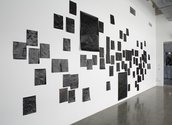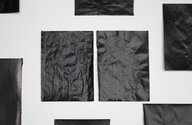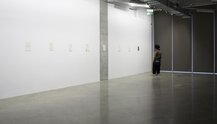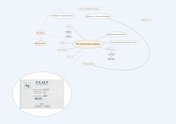John Hurrell – 18 October, 2010
Huddleston's title comes from the famous Austrian novel by Robert Musil, The Man Without Qualities and 'It happened that' as a phrase has a sense of the passive tense about it; and for each agent or event, an undermining of the historical certitude of ‘the facts' or their existential weight. ‘It so happened that' or ‘As it happened…' probably get to the gist of this show better.
Auckland
Christian Capurro, Maddie Leach, Sriwhana Spong and Sean Lynch
It Happened That
Curated by Charlotte Huddleston
I October - 29 October 2010
This is unusual show is of a variety that is becoming more frequent, one that examines the relationship between reality, possibility, and the negotiable bridge between the two of language. Huddleston’s title comes from the famous Austrian novel by Robert Musil, ‘The Man Without Qualities’ and It happened that as a phrase has a sense of the passive tense about it; and for each agent or event, an undermining of the historical certitude of ‘the facts’ or their existential weight. ‘It so happened that’ or ‘As it happened…’ probably get to the gist better.
Such inflections are important because the artists Huddleston has chosen look at highly ambiguous images or continually changing properties, and challenge us to try and pin down what might coincidentally occur in their creation out of a range of potential options, or ‘what could this be now?’ In these alternatives we try to grasp what seems ungraspable - what escapes the reach of conventional description or historical narrative?
Melbourne artist Christian Capurro works with the paper pages of fashion magazines, using treatments that obliterate the original images either through additive coats of brushed on acrylic paint or correction fluid or through subtractive erasures achieved through prolonged friction with a rubber. In both these highly obsessive methods there is a suggestion of unforeseen replacement images appearing - either through the textures of the paint or Twink application, via a stretching or directional warping of the thin paper, or through printed ink seeping through from the other side.
The pinned up black additive works are highly suggestive of night, blindness (as imagined by the seeing) or fire damage. The pale Compress works in turn are fascinating with their waxy oily sheen, odd blobby shapes delineated by greasy stains or caressed on, stroked and feathery white fluid. They are extraordinarily mysterious.
With the three films contributed by Sriwhana Spong their long titles state a pinhole camera was pointed at certain objects in particular spaces - but that may or may not have been the case. In two of them the imagery is not ‘realistic’ but more about intruding light and random exposure of unfocussed film. Spong’s flickering coloured streaks and jumping specks (postproduction ‘blemishes’ in one work digitally added later) are affected by the titles as you strain to find correlations with the stated descriptive language. The work seems a conceptual blend of Michael Craig-Martin’s 1973 An Oak Tree (his title for a glass of water resting on a glass shelf), and Julian Dashper’s ‘last few seconds of the 2007 Venice Biennial’ video.
Sean Lynch is an Irish artist who presents a carousel of thirty slides that overlap and dissolve in a sequence, depicting shimmering evening sunlight on an empty North Atlantic - as seen off the western coast of Ireland. The filmed location is the site of an imagined island called HyBrazil often described and mapped in the fourteenth century. Four such maps are provided (they greatly vary), and Lynch asks us to look for hints of landforms within the distant golden low-lying cloud, and what - like the mythical lost continent of Atlantis - might have been.
Maddie Leach’s project is less object based, though a one kg bullion bar of solid silver is certainly memorable, perhaps as an extravagant cast paperweight bearing decorative hallmarks. The focus though is not on the physical item but its fluctuating daily market value - figures calculated for the possibility of reselling or purchase of another - and both amounts can be compared with what Leach originally paid. A wider contextual explanation is provided by Leach’s complex XMind diagram along with an informative downloaded mini-lecture by Mark Griffiths on how to invest in precious metals.
In an essay that is about to appear in the show’s catalogue, Huddleston mentions Odo Marquard’s discussion of Aristotle’s separation of the ‘arbitrarily accidental’ from the ‘fatefully accidental’. The former we can change or reject, the latter we can’t. We can see Capurro and Spong (with creative freewill) are linked to one; Leach and Lynch (referencing the forces of history) are bound to the other.
Huddleston’s exploration of the finer points of contingency makes an intriguing exhibition and the four artists, a good combination. As they prod us to ponder the nuances of possibility these carefully positioned works provide an excellent introduction to Huddleston’s curatorial skills (she has only recently arrived as St. Paul St) and are essential viewing.
John Hurrell







 Two Rooms presents a program of residencies and projects
Two Rooms presents a program of residencies and projects Advertising in this column
Advertising in this column



This Discussion has 0 comments.
Comment
Participate
Register to Participate.
Sign in
Sign in to an existing account.